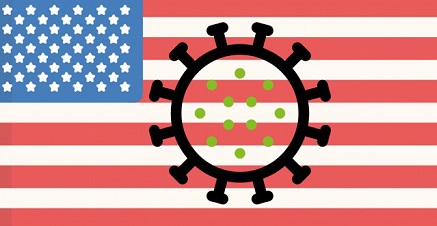COVID-19 News-United States: Previous Week’s COVID-19 Hospitalizations Hits 34,800! About 230 Americans Die Per Day From COVID-19! JN.1 Mild?
Nikhil Prasad Fact checked by:Thailand Medical News Team Jan 06, 2024 1 year, 10 months, 3 weeks, 1 day, 11 hours, 40 minutes ago
COVID-19 News-United States: The specter of COVID-19 continues to cast its shadow over the United States, with the latest data revealing a staggering surge in hospitalizations and an alarming death toll. The emergence of the JN.1 variant, a subvariant of omicron, has raised serious concerns among public health officials and experts. In this
COVID-19 News-United States report, we delve into the intricate details of the current situation, exploring the characteristics of the JN.1 variant, the trajectory of COVID-19 hospitalizations, and the imperative need for enhanced public health measures.
 COVID-19 Hospitalizations Adn Deaths Increasing In America
The JN.1 Variant: A Swift Ascent
COVID-19 Hospitalizations Adn Deaths Increasing In America
The JN.1 Variant: A Swift Ascent
The U.S. Centers for Disease Control and Prevention (CDC) reports that the JN.1 variant has swiftly become the dominant strain in the U.S., accounting for an estimated 62% of COVID-19 cases in recent weeks. This represents a remarkable surge from its presence at around 3% in November. The rapid transmission rate of the JN.1 variant has raised concerns about its potential impact on public health.
https://covid.cdc.gov/covid-data-tracker/#variant-proportions
The Northeast region of the U.S. has become the epicenter of JN.1 prevalence, with an estimated 74.9% of COVID-19 cases attributed to this variant. This regional concentration highlights the need for targeted interventions and heightened surveillance to curb the spread of the virus.
Omicron Subvariant Dynamics
JN.1 is classified as an omicron subvariant, closely related to BA.2.86 variant. The U.S. CDC has assured the public that, as of the current assessment, there is no evidence suggesting that JN.1 poses an increased risk compared to other circulating variants. However, the agency is closely monitoring the situation, emphasizing the dynamic nature of the virus.
Hospitalizations Soar: The Alarming Statistics
As the JN.1 variant tightens its grip on the nation, the resurgence of COVID-19 hospitalizations is reaching levels not witnessed since the previous winter. In the last week alone, the U.S. recorded nearly 34,800 new COVID-19 hospital admissions, according to U.S CDC data.
https://covid.cdc.gov/covid-data-tracker/#maps_new-admissions-rate-county
This alarming figure underscores the urgent need for enhanced public health measures to curb the escalating crisis.
Emergency department visits for COVID-19 are on the rise, with infants and older adults experiencing the highest rates. However, public health experts note that, despite the high levels of infection measured using wastewater viral activity and test positivity data, severe disease is occurring less frequently than earlier in the pandemic.
The Escal
ating Death Toll
While the severity of individual cases may be decreasing, the overall death toll is on the rise. The week ending December 9 saw a staggering 1,600 COVID-19-related deaths, according to provisional death data.
It was reported that the officially, an average of 230 Americans die from COVID-19 each day for the last few weeks based on the criteria for classifying COVID-19 deaths. However, many doctors say that the actual figures are many fold and that in many cases the deaths are attributed to other causes such as heart failures, organ failures, sepsis etc despite all being COVID-19 induced! The excess mortality rates in the US are also rising exponentially over the last few weeks.
Public health experts are sounding the alarm, urging Americans to prioritize vaccination to prevent severe illness. Unfortunately, vaccine uptake remains disappointingly low, posing a significant challenge to achieving widespread immunity.
Understanding the JN.1 Variant
The JN.1 variant, as an omicron subvariant, has garnered attention due to an additional mutation in its spike protein compared to its parent, BA.2.86. The spike protein is a key element in the virus's ability to attach to and infect cells. Experts posit that this mutation may render the JN.1 variant more transmissible or better at evading the immune system than other circulating variants.
Dr Peter Chin-Hong, a professor of medicine and infectious disease expert at the University of California, San Francisco, acknowledges the concerning rate of JN.1's increase. He underscores the success of the U.S. in tracking and identifying new variants, expressing confidence in the ability of public health systems to respond effectively.
Challenges and Recommendations: Navigating the Complex Landscape
With COVID-19 hospitalizations rising for the eighth consecutive week, the challenges posed by the JN.1 variant underscore the dynamic nature of the virus. Public health experts emphasize the need for continuous vigilance and adherence to preventive measures.
Despite no evidence suggesting JN.1 causes different symptoms or leads to more severe illness, the imperative for updated vaccines becomes evident. Only 19.4% of adults aged 18 and older have received the latest vaccine, according to CDC data.
https://www.cdc.gov/respiratory-viruses/data-research/dashboard/vaccination-trends-adults.html
the U.S. CDC has highlighted the importance of updated vaccines, especially for older individuals and those who are immunocompromised, as immunity tends to wane over time.
Conclusion
As the United States navigates the resurgence of COVID-19, the prominence of the JN.1 variant adds layers of complexity to an already challenging situation. The rapid spread of this omicron subvariant necessitates an urgent and coordinated response, emphasizing the importance of vaccination, enhanced public health measures, and continued surveillance. The evolving landscape of the pandemic demands a proactive approach, with individuals and communities remaining informed, vigilant, and committed to mitigating the impact of the JN.1 variant.
For the latest
COVID-19 News-United States, keep on logging to Thailand Medical News.
